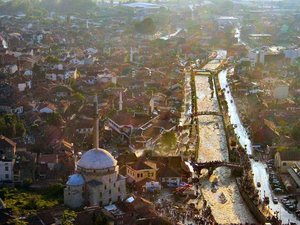Prizren
|
|
Prizren (Serbian Cyrillic Призрен; Albanian Prizreni) is an historic city located in Kosovo at 42.23° North, 20.74° East. In 2003 the city had a population of about 124,000. It is the administrative capital of Prizreni District, which has an estimated population of about 178,000 and is located on the slopes of the Šar mountain in the south-western part of the country, close to the Albanian border.
The original Prizren dialect of Serbo-Croatian is an archaic variant of shtokavian - and a member of the Balkan sprachbund.
| Contents |
History
The city of Prizren has existed for at least a thousand years, becoming the seat of a bishopric under the Byzantine Empire in 1019. It was taken by the Bulgarians in 1204 and by the Serbs in 1282. It became the capital of the medieval Serbian state under Tsar Stefan Dušan in the 14th century before falling to the invading Ottoman Empire in 1455. Prizen was then made the administrative capital of an Ottoman vilayet (province) covering most of present-day Kosovo. It was a prosperous city, benefitting from its position on the north-south and east-west trade routes across Kosovo.
Prizren was the cultural and intellectual centre of Ottoman Kosovo. It was dominated by its wealthy Muslim Albanian population, who comprised about 70% of its population in 1857. During the late 19th century the city became a focal point for Albanian nationalism and saw the creation in 1878 of the League of Prizren, a movement formed to seek the national independence of Albania from the Ottoman Empire.
The city was taken by Serbia in 1912 in the First Balkan War and was absorbed into its teritorry. Although the city surrendered peacefully, its takeover was extremely bloody. The British traveller Edith Durham attempted to visit it shortly afterwards but was barred by the authorities, as were most other foreigners. A few did make it through—including Leon Trotsky, then working as a journalist—and reports eventually emerged of widespread killings of Albanians. One of the most vivid accounts was provided by the Catholic Archbishop of Skopje, who wrote an impassioned despatch to the Pope on the dire conditions in Prizren immediately after its capture by Serbian forces:
- The city seems like the Kingdom of Death. They knock on the doors of the Albanian houses, take away the men, and shoot them immediately. In a few days the number of men killed reached 400. As for plunder, looting and rape, all that goes without saying; henceforth, everything is permitted against the Albanians, not merely permitted but willed and commanded. (quoted in the Irish Times, 5 May 1999 [1] (http://www.ess.uwe.ac.uk/Kosovo/Kosovo-Current_News143.htm))
Prizren was taken by Austria-Hungary only two years later, during the First World War, and was handed over to Bulgaria in 1916. Serbian forces regained control in October 1918 on the withdrawal of the Central Powers from southern Serbia.
For many years after the restoration of Serbian rule, Prizren and the region of Decane to the west remained centres of Albanian nationalism. In 1956 the Yugoslav secret police put on trial in Prizren nine Kosovo Albanians accused of having been infiltrated into the country by the (hostile) Communist Albanian regime of Enver Hoxha. The "Prizren trial" became something of a cause celébre after it emerged that a number of leading Yugoslav Communists had allegedly had contacts with the accused. The nine accused were all convicted and sentenced to long prison sentences, but were released and declared innocent in 1968 with Kosovo's assembly declaring that the trial had been "staged and mendacious."
Prizren in the Kosovo War
Prizren and its surrounding municipality were badly affected by the Kosovo War of 1998-1999. Before the war, the OSCE estimated that the municipality's population was about 78% Kosovo Albanian, 5% Serb and 17% from other national communities, with the city's population being 69.25% Kosovo Albanian, 10.30% Serb and 20.45% of other national communities. During the war, virtually the entire Albanian population was expelled by Yugoslav security forces and paramilitaries with an unknown number of people being killed in the process. [2] (http://www.osce.org/kosovo/documents/reports/hr/part1/p5prz.htm)
At the end of the war in June 1999, most of the Albanian population returned to Prizren. Non-Albanian minorities fled or were forcibly expelled, with the OSCE estimating that 97% of Serbs and 60% of Roma had left Prizen by October. Several dozen people, mostly Kosovo Serbs, were murdered and scores more reported harassment and intimidation. The community is now almost entirely ethnically Albanian. [3] (http://www.osce.org/kosovo/documents/reports/hr/part2/07e-prizren.htm)
The war and its aftermath caused only a moderate amount of damage to the city, with NATO bombing confined to a number of military and security force sites in and around Prizren. Serbian forces destroyed a number of Albanian cultural monuments, such as the League of Kosovo building, to which the returning Albanians responded by destroying Serbian cultural monuments such as old Eastern Orthodox churches. Our Lady of Ljeviš and Holy Salvation were both torched by Albanians on March 17, 2004 in a serious outbreak of unrest in Kosovo.
External links
- The official website of the Municipality of Prizren (http://www.prizreni-komuna.org/)
- Komuna Prizren (http://www.komuna-prizren.org/)
See also
Reference
- Data taken from "The World Gazetteer" (http://www.world-gazetteer.com )

